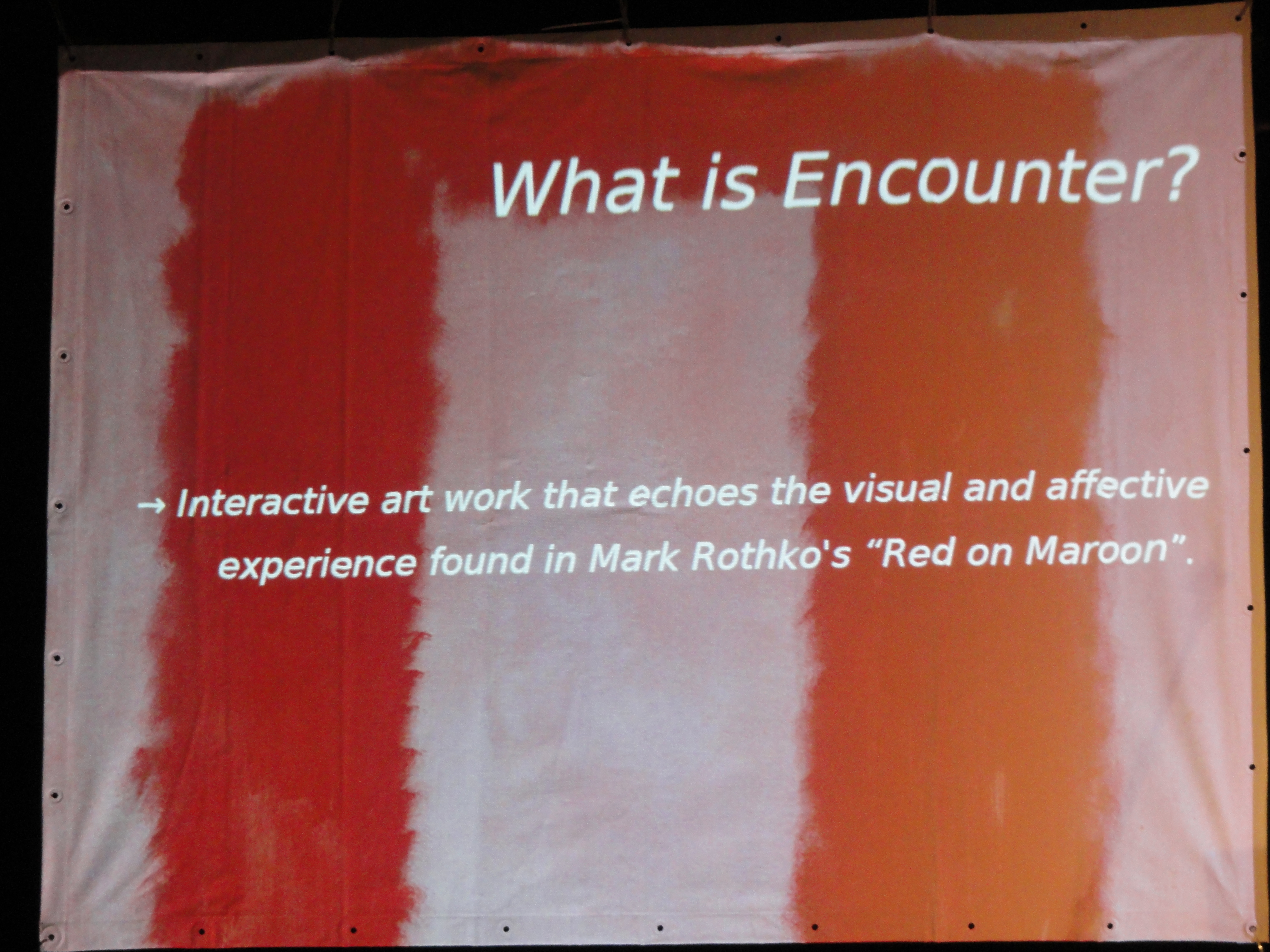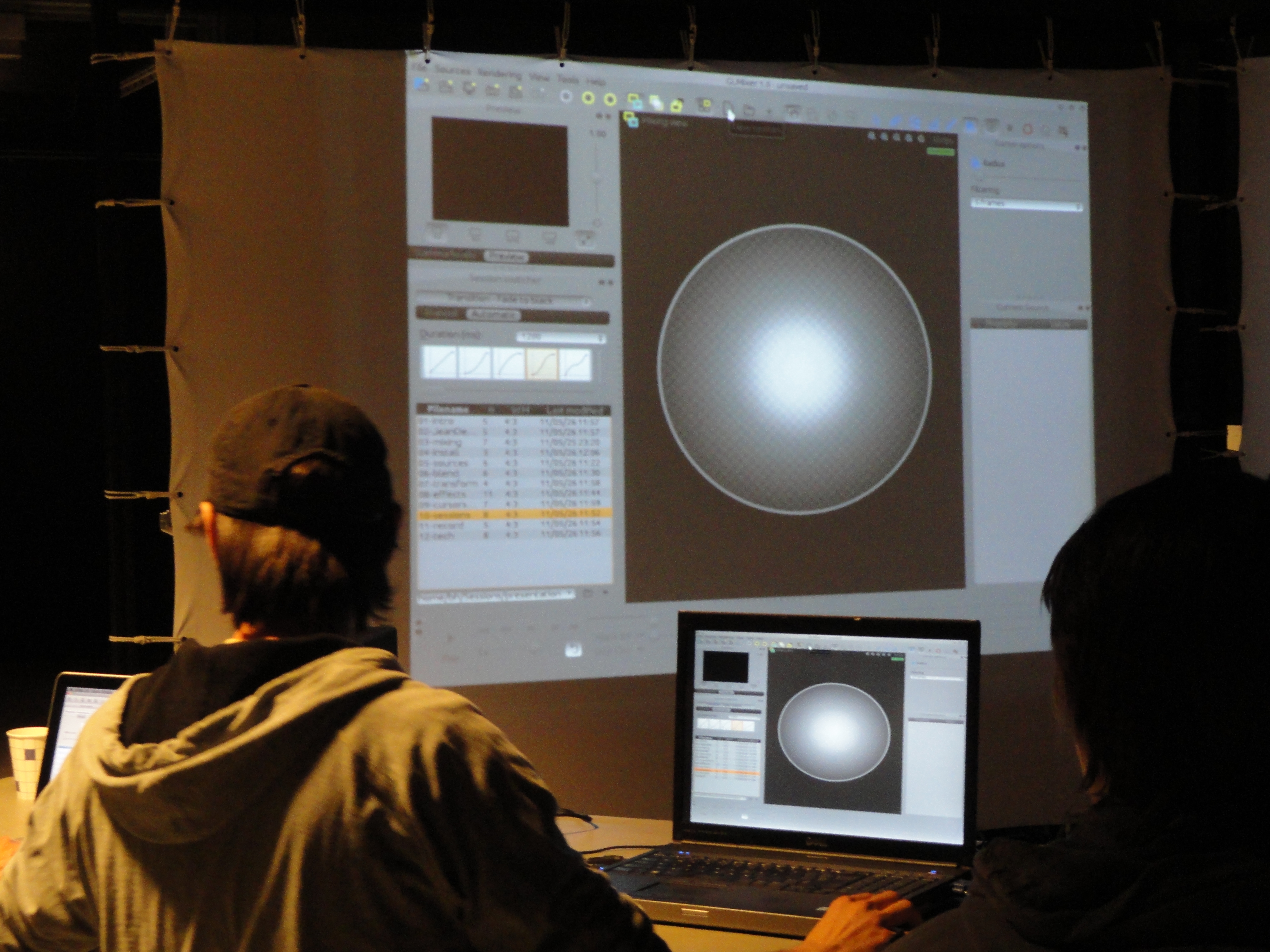As the first day ended it beginns: very relaxed and informal. People are easy and always open to talk with. Everybody is interested in the work of the others. It does not matter if you're an artist, nerd,  programmer, visitor or studend. Everybody chats with everyone. This way is the key to get connections, be inspired, think in new ways and get to know what's behind. The artists are reachable instead of being just on stage to talk, show their work and go. This kind of special atmosphere is what this festival makes it remarkably.
programmer, visitor or studend. Everybody chats with everyone. This way is the key to get connections, be inspired, think in new ways and get to know what's behind. The artists are reachable instead of being just on stage to talk, show their work and go. This kind of special atmosphere is what this festival makes it remarkably.
Day two - the festival starts with a keynote by Christian Jaquemin from Paris.
It's all about projection, argumented reality/image processing. 
Christian talks about the virtual world and the real world and its perception and the use in an artistic way. How does a subject in the real world perceives the virtual world? There're issues on the point of view from where one looks at the projection, because it might look different from various angles. Especially in 3D projection. One way to deal with it, is to project on 3D objects, like an organ or the inside of a church. The calibration is the main key to make it work or not. But if one works with a mobile object, like a boat, the calibration might become a problem of being precise. Christians main interest lies in working with the "physical" shadow. People often try to not have any physical shadow, cut it out and so on. But he wants to use it on purpose in order to project into this shadow.
He will give his workshop on Friday 
Christian Jaquemin // art-on-wires.org/christianjaquemin
Research projects // vida.limsi.fr
After a small coffee break we all start with the workshops.
Swarm Cubes (Part 1)
DKIA: Nora Dibowski and Simon Laburda
With a new gimmick, a LED cube, DKIA give another "sewing" workshop. Many little wires get soldered together and in between are LEDs and on the bottom some electronic. Goal is to have two of these to let them communicate with each other through a mobile phone for instance. They would make some sounds and light up their LEDs. Nerd toys. But beautiful.
let them communicate with each other through a mobile phone for instance. They would make some sounds and light up their LEDs. Nerd toys. But beautiful.
The Hitch Hikers Guide To Circuit Bending and Junkbot
Philip Fischer, Michal Wlodkowski, Erkin Bayirli 
Also here again like last yea. Many kids toys will be brought out of their normal context. Soldering here and there, putting some electronical stuff inside or use what's there and change it, you'll have a very colorful toy which makes sounds it usually doesn't do.
Ableton Live
Jacob Korn
A beginner how to make true Techno music workshop. I'm always sad I can't make it. Just to have my own techno computer (because I taught my own workshop).
A Gaga-based Dance Class
Johanna Roggan
Giving a movement class for choreographers and total beginners is always (good) fun. For me at least. But what they all have in common is the need to sink into what I'm talking about and really take the time to establish the pictures I'm giving in by my voice. The constant checking what is the given image and how does it feel inside me is an ongoing process. Especially when bringing it into movement. It needs an informal, safe atmosphere in order to open a little and let things happen without control. Basically it's about finding a movement which fits to the image somebody (me in that case) gives in. This way of interpretation is very personal and physical on a even anatomic level. So there is no right or wrong. There is just I feel it or not.
tasty lunch break and we gon on with:
Swarm Cubes (Part 2)
DKIA: Nora Dibowski and Simon Laburda
The Hitch Hikers Guide To Circuit Bending and Junkbot
Philip Fischer, Michal Wlodkowski, Erkin Bayirli 
glMixer – A New Tool for Live Video Mixing 
Bruno Herbelin
VVVV – An introduction into the Multipurpose Toolkit
Marko Ritter, Valérie Francois Vogt 

